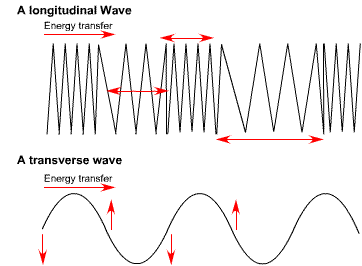Two types of waves exist: transverse and longitudinal.Both of these wave-types are traveling disturbances, but they are different because of the way that they travel. As a wave travels through a medium, the particles that make up the medium are disturbed from their resting, or “equilibrium” positions.After either type of wave passes through a medium, the particles return to their equilibrium positions. Thus, waves travel through a medium with no net displacement of the particles in the medium.
Transverse Waves



(A transverse wave. The particles move in a direction that is perpendicular to the direction of wave propagation.)
A transverse wave is one that causes the particles of the surrounding medium to vibrate in a direction at right angles to the direction of the wave. In a transverse wave, the particles are disturbed in a direction perpendicular to the direction of source(Vibration).A water wave is an example of a transverse wave. As water particles move up and down, the water wave itself appears to move to the right or left.Another example of these types of waves are light waves.

Longitudinal Waves

(A longitudinal wave, made up of compressions - areas where particles are close together - and rarefactions - areas where particles are spread out. The particles move in a direction that is parallel to the direction of wave propagation.)
In a longitudinal wave, the particles are disturbed in a direction parallel to the direction that the wave propagates. A longitudinal wave consists of “compressions” and “rarefactions” where particles are bunched together and spread out, respectively.
The direction of the wave motion is parallel to the direction to the direction of vibration.
Sound Waves are an example of longitudinal waves.
Comparison between transverse and longitudinal waves
----------------------------------------
Transverse waves
Definition:
The particles of the medium vibrate
at right angles to the direction of
wave motion
Longitudinal waves
Definition:
The particles of the medium vibrate
parallel to the direction of wave
motion.
----------------------------------------
Transverse waves
Movement:
The wave is propagated in the form
of crests and troughs
Longitudinal waves
Movement:
The wave is propagated in the form
of compressions and rarefactions.
-----------------------------------------
Transverse waves
Medium:
This type of wave motion is possible
in solids and on liquid surfaces
Longitudinal waves
Medium:
This type of wave motion is possible
in any medium (solid, liquid or gas)
-----------------------------------------
Transverse waves
Polarization:
These waves Can undergo polarization
Longitudinal waves
Polarization:
These waves do not undergo polarization
-----------------------------------------
Questions:
1. A transverse wave is transporting energy from east to west. The particles of the medium will move_____.
a. east to west only
b. both eastward and westward
c. north to south only
d. both northward and southward
(See Answer)
2.A wave is transporting energy from left to right. The particles of the medium are moving back and forth in a leftward and rightward direction. This type of wave is known as a ____.
a. mechanical
b. electromagnetic
c. transverse
d. longitudinal
(See Answer)
3. Describe how the fans in a stadium must move in order to produce a longitudinal stadium wave.
ANSWER
4. If you strike a horizontal rod vertically from above, what can be said about the waves created in the rod?
a. The particles vibrate horizontally along the direction of the rod.
b. The particles vibrate vertically, perpendicular to the direction of the rod.
c. The particles vibrate in circles, perpendicular to the direction of the rod.
d. The particles travel along the rod from the point of impact to its end.
See Answer
No comments:
Post a Comment